Star Wars semiotics
By:
July 14, 2010
Editor’s note: This is one of the most popular posts, traffic-wise, ever published on HiLobrow. Click here to see a list of the Top 25 Most Popular posts (as of October 2012); and click here for an archive of all of HILOBROW’s most popular posts.
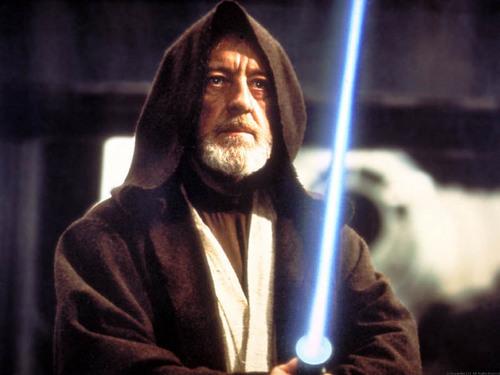
Over at the blog Star Wars Modern, the Brooklyn-based sculptor/theorist John Powers has decided to map the “visual program” of Star Wars IV. In order to do so, he’s appropriated the so-called Klein Four-Group diagram [better known — e.g., to those of us familiar with Frederic Jameson’s use of the tool — as a Greimas or Semiotic Square] employed by art critic/theorist Rosalind Krauss to map “sculpture in the expanded field” back in 1978.
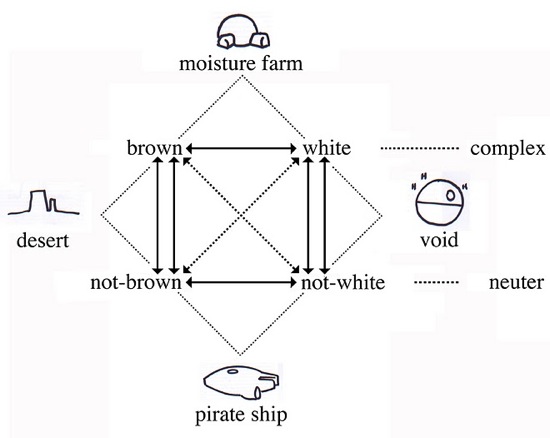
According to one Greimas exegete, who in this quote sounds like a Magister Ludi, the semiotic square is
a map of logical possibilities. As such, it can be used as a heuristic device, and in fact, attempting to fill it in stimulates the imagination. The puzzle pieces, especially the neutral term, seldom fall conveniently into place…. Playing with the possibilities of the square is authorized, since the theory of the square allows us to see all thinking as a game, with the logical relations as the rules and concepts current in a given language and culture as the pieces.
Here, for what it’s worth, is Krauss’ diagram:
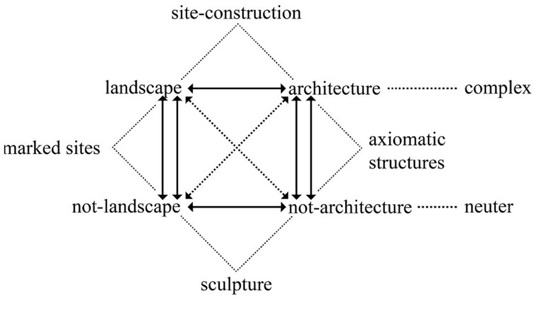
At HiLobrow we’re wary of structuralist heuristic devices. But we do enjoy tinkering with them — and we’ve noticed that the logical expansion of binary oppositions does help stimulate the imagination. However… does Powers’ square function properly?
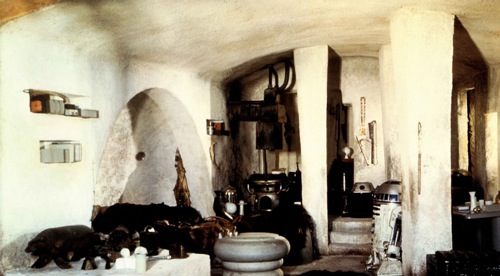
For his Star Wars square’s (positive) Position A and (negative) Position B terms, Powers has inserted the binary pair “Brown” vs. “White” — language he’s borrowed from Le Corbusier, who described a “white world” of precision, clarity, and order, and a “brown world” that is cluttered and muddled. Powers doesn’t give examples of these positions, but it’s pretty obvious what fits there. In Star Wars, the Stormtroopers‘ are interchangeable clones in mass-produced (white) uniforms. Obi-Wan/Luke/Leia, meanwhile, are “brown” Emersonian individualists. Obi-Wan’s robes (shown below) and dwelling (shown above) are natural, organic in shape and color, handmade and homely. Position A’s term = Obi-Wan, Luke and Leia. Position B’s term = Stormtroopers.
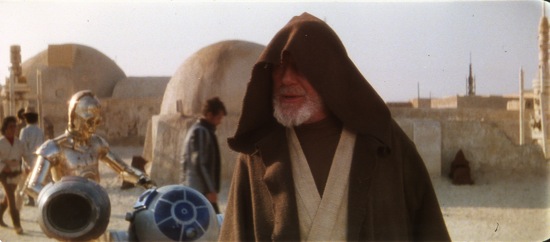
Note that Leia’s white robes are a disguise, worn while she’s acting as a double agent; and Luke’s farmboy garb is off-white, dusty, soiled. But so are the stormtroopers’ uniforms (shown below). As will be explained, the Stormtrooper and Obi-Wan, Luke and Leia aren’t contradictory “terms” on our diagram; they’re merely conflicting. Position A and Position B — like “Nature” and “Culture” themselves — have more in common than we’ve all been led to suspect.
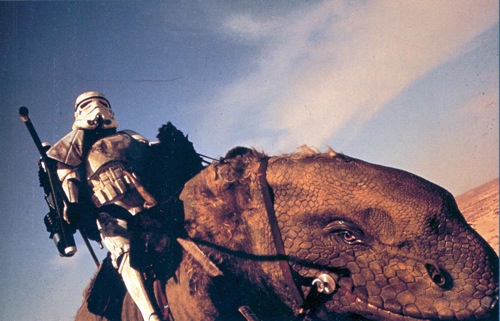
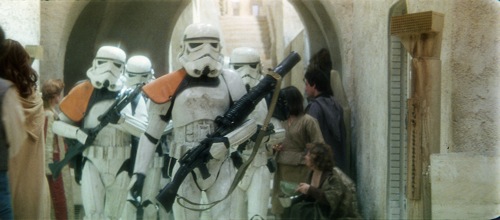
Does Star Wars ask: whose worldview and style of life will triumph? Yes, it does. It asks, at a superficial level: Will Obi-Wan’s, Luke’s and Leia’s worldview — which privileges constitutional monarchy and/or parliament, and agrarian social orders — triumph? Or will the Stormtroopers’ — which privileges military dictatorship and industrialism/capitalism?
Powers is off to a promising start, with his “Brown” and “White” terms. However, like Krauss, who mistakenly suggests that A and Not-B (also B and Not-A) are really the same thing, Powers is not interested in articulating the terms Not-A and Not-B, and instead jumps to the square’s “metaterms” (which we’ll get to soon). That’s a major oversight!
So let’s help Powers out — what are “Not-White” and “Not-Brown” in Star Wars?
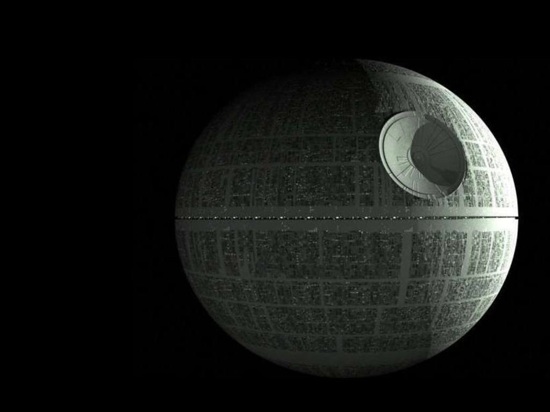
Position Not-A (Not-Brown, in Powers’ square) is an extremist version of Position B. Only something ultra-high-tech, inhumanly mechanized, anti-nature/life can fit here. The answer is obvious: the Death Star. Is the Death Star more extreme, in its “Whiteness,” than the Storm Troopers? Yes — plus, its stormtrooper’s uniforms (unlike the stormtroopers on Tatooine, say) are spotless and gleaming, as is its architecture.
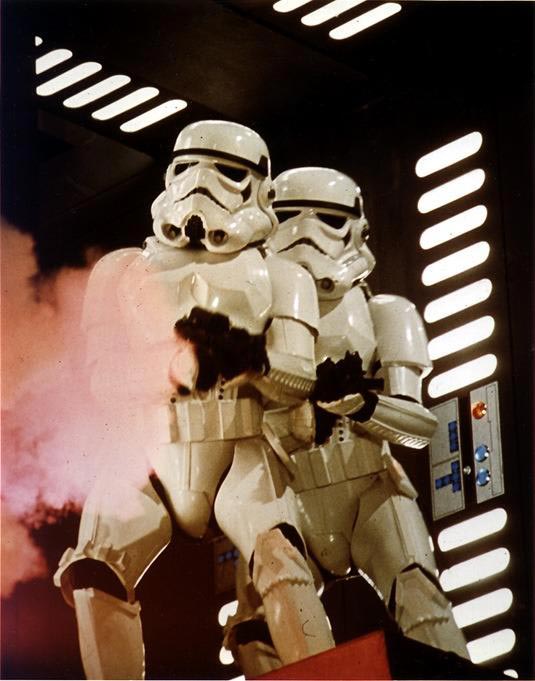
Position Not-B (Not-White, in Powers’ square) represents an extremist version of Position A. Only something wild and woolly can fit into the Not-White position. One might be tempted to say: Chewbacca! But Jameson and others warn us that Position Not-B is a tricky one, never an obvious answer. Once Position Not-B is figured out, the more extreme opposition underlying the A-B binary is revealed. After giving this some thought, I’m going to go out on a limb and argue that the Non-White position, in the Star Wars semiotic square, is occupied by Non-Human Aliens. Are the movie’s non-human aliens more natural, organic, and homely than Obi-Wan, Luke and Leia? Without question — see the Cantina scene.
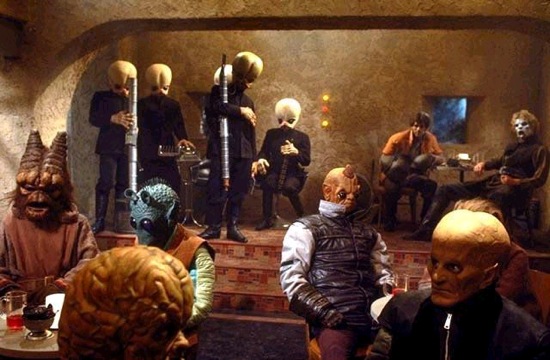
Here’s the insight we gain from having identified the four central terms of the Star Wars semiotic square. Despite George Lucas’ attempt to cobble together a middlebrow entertainment following Joseph Campbell’s template, it turns out that the Obi-Wan, Luke and Leia vs. Stormtroopers relationship is merely a contrary one. Obi-Wan, Luke and Leia use advanced technology, shoot laser guns, fly spaceships. And the Stormtroopers originally fought for the Republic; they just follow orders — they’re not motivated to snuff out Luke and Leia’s entire way of life. In later — I mean earlier — installments of the series, we feel sorry for the mind-controlled, Brave New World-ish drones. The movie’s deeper conflict is harder to spot, but the semiotic square has aided us.
The Death Star vs. Non-Human Aliens relationship is a contradictory one, an all-or-nothing conflict. At some level, then, viewers of Star Wars understand that the larger stakes here are genocide, politicide, ethnic cleansing, culturecide. Whether he knew it or not, Lucas was making a movie about Western imperialism in the era of decolonization; not to mention Pakistan ’71, Uganda ’72-’79, Philippines ’72-’76, Pakistan ’73-’77, Chile ’73-’76, Angola ’75-2001, Cambodia ’75-’79, Indonesia ’75-’92, Argentina ’76-’80, and Ethiopia ’76-’79.
Therefore, though it’s never articulated, the most poignant aspect of Star Wars IV is not whether Luke will rescue Leia, but whether the Death Star will be completed — and then used to wipe out non-human species. Note that the only non-human we see on the Death Star is the trash monster. Later Star Wars movies will stress the pan-species nature of the Rebel Alliance, thus making much more explicit the series’ most fraught significance.
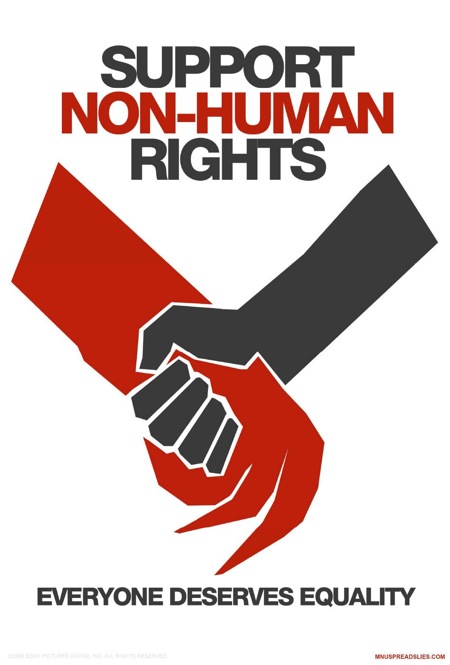
If Star Wars is ultimately about the struggle of non-human aliens to survive a campaign of genocide, why are its protagonists (mostly) human? For the same reason that Kevin Costner’s character is the hero of Dances With Wolves; it’s presumed that viewers wouldn’t be able to relate to non-white (or non-human) heroes. One of the great things about the recent SF movie District 9 is how it messes with this presumption — its unsympathetic human protagonist becomes an alien.
By the way, Position Not-B privileges primitive capitalism and clan-oriented social orders. Position Not-A privileges totalitarianism — or perhaps “totalitarian democracy” and/or the sort of hierarchical social order outlined in Plato’s Republic and touted by Leo Strauss.
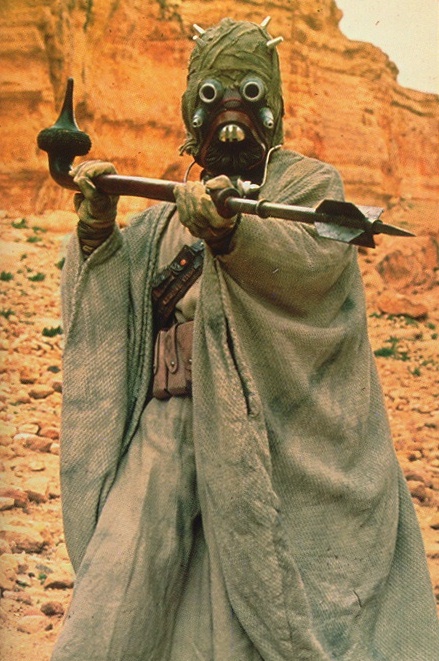
Now for the square’s metaterms. In Star Wars‘ visual program, what [low-middlebrow] phenomenon might be said to bridge Positions A (Obi-Wan, Luke and Leia) and Not-B (Non-Human Aliens)? Powers’ diagram claims the answer is: Desert. But that’s not so: the Desert is a Not-White phenomenon, a lawless and chaotic Brown wilderness where non-human aliens roam free and clash by night. The Jawas, the Tusken Raiders — Luke learns that they’re not his adversaries; they’re the ones he’s fighting to protect. (OK, this isn’t made explicit. But look at how the Jawas go from being annoying parasites to victims of state terror; and consider how Obi-Wan deals with the Tusken Raiders — instead of fighting them off, he’s gentle, nonviolent, compassionate.)
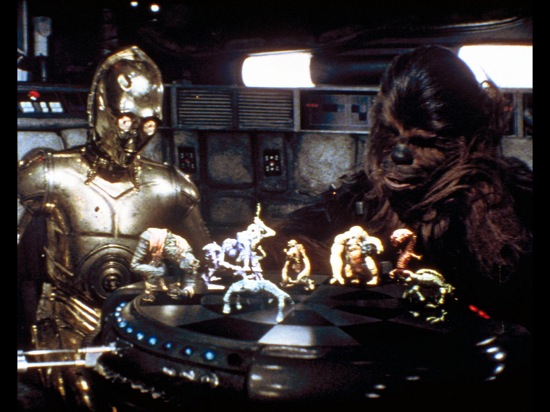
So what figure bridges Positions A and Not-B? The answer, of course, is Chewbacca — a character whom we’re encouraged to find simultaneously human/sympathetic and alien/scary (cf. Han’s warning about playing chess with Chewie). Yes, you heard it here first: Chewbacca is low-middlebrow. Jar-Jar and the Ewoks — we knew they were middlebrow. But Chewie? Yep.
PS: You see what I did? I mapped our highbrow-lowbrow-middlebrow-nobrow-hilobrow schema onto Greimas’ semiotic square. And not for the first time, either. This doesn’t mean we’ve uncritically accepted Greimas’ heuristic; we’re not structuralists. But for the moment, we do find the semiotic square useful. Obi-Wan, Luke and Leia are in the square’s lowbrow position, while the Stormtroopers are in its highbrow spot. Note that “highbrow” and “lowbrow,” as used here, have nothing to do with levels of intelligence. Also note that Lowbrow and Highbrow, like Brown and White, have more in common than we’ve all been led to suspect.
So what [high-middlebrow] phenomenon might be said to bridge Positions B (Stormtroopers) and Not-A (Death Star)? Powers’ diagram claims the answer is: Death Star. That’s not so; we’ve already noted that the Death Star belongs in Position Not-A. The answer is: Imperial officers. They occupy an awkward yet advantageous position between the Stormtroopers and the Death Star; Darth Vader snuffs a couple of them in the course of Star Wars, yet he’s ordered around by Grand Moff Tarkin.
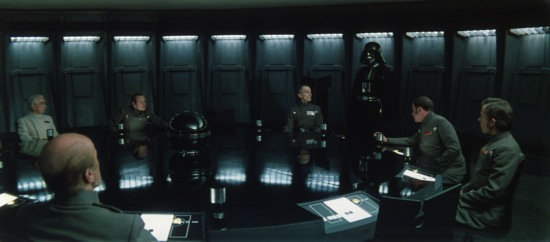
The Imperial officers in Star Wars are Nazis, basically. Sentimental middlebrows like Lucas and Steven Spielberg find Nazis to be convenient bad guys — because audiences don’t/can’t think about them. (Indiana Jones: “Nazis… I hate these guys!”) Nazis are the middlebrows’ favorite villain — which does not mean Nazis are not evil. What it means is this: the way Nazis (as opposed to average German soldiers) are used as bad guys in our culture should be carefully scrutinized. The heroes who fight the Nazis in middlebrow movies — what are their real ideals?
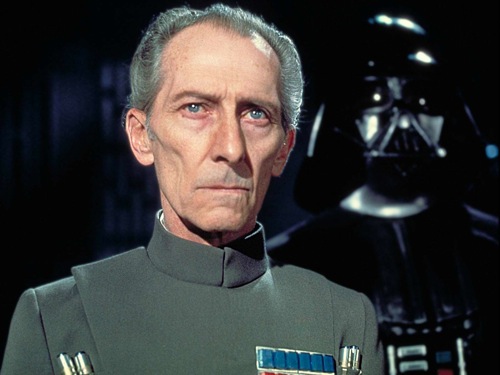
The other metaterms are trickier. In Star Wars‘ visual program, what [nobrow] phenomenon fits in the semiotic square’s “neutral” position — i.e., what’s neither Brown nor White, neither Obi-Wan/Luke/Leia nor Stormtroopers? Is there a figure who doesn’t care what happens to any of these characters? The answer is: the Emperor, who is above it all, an avatar of scornful irony.

The Emperor, who is mentioned but neither named nor shown in Star Wars: A New Hope, is a Sith. Which is to say, he’s an agent of [Moorcockian] Chaos who’d just as happily destroy the Empire as he would the Republic, if it suited him. He’s not cool or glamorous, though he is charismatic in his way. He’s an Ubermensch who laughs down his nose at everyone.
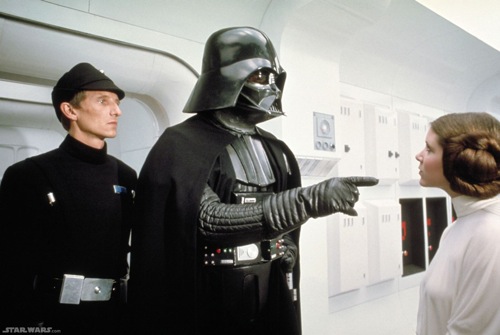
So what about Darth Vader? Vader is also a nobrow figure — but we find his coolness attractive, at some level. And that makes him cooptable by middlebrow — which explains his power struggle with Tarkin [a high-middlebrow figure], and also his later transformation into a [low-middlebrow] cuddly monster/alien who kills the Emperor before sentimentally pleading with Luke to take off his helmet so he can look at his son with his own eyes. It doesn’t get more kitschy than that.
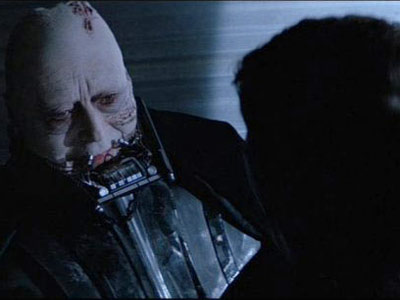
At HiLobrow we call the nobrow phenomenon that’s been coopted by middlebrow QUATSCH. So: Darth Vader is quatsch. Eventually, I mean — not in episodes IV and V. Though even in those episodes Vader’s bad-ass, glamorous coolness, which is so unlike the Emperor’s above-it-all frigidity, is a symptom of quatsch. The true nobrow is a sociopath; the alienated man or woman who disguises his or her disappointment and fear and injured pride by affecting nobrow irony and disaffection, is quatsch.
Powers places the Millennium Falcon (“pirate ship”) into the nobrow position on his square, and I think that’s almost correct. Han Solo is certainly a nobrow — cool, detached, a mercenary who cares only about himself. But like Vader, he’s secretly sentimental — e.g., when he says “The Force be with you” to Luke, or when (SPOILER) he returns to help Luke destroy the Death Star at the end of the movie. As a sentimental nobrow, Solo is cooptable by middlebrow. Han Solo is quatsch, too.
In the later/earlier movies, we learn that to become a Jedi is to become nobrow. Though the finest Jedi eventually realize that it’s preferable to be lowbrow — living in a simple hut, chopping wood and carrying water and communing with natural energies. Or is this a middlebrow fantasy: fake authenticity, nostalgie de la boue?
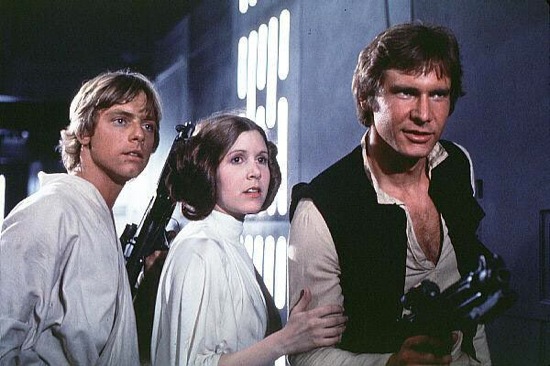
As for the semiotic square’s fourth and final metaterm, what Star Wars phenomenon fits in the semiotic square’s “complex” position — i.e., the position uniting the square’s original binary opposition (Brown: Obi-Wan, Luke and Leia vs. White: Stormtroopers)? There are actually two possibilities within this metaterm: combining Positions A and B in a dialectical synthesis, or combining Positions A and B in a negative-dialectical, non-synthetic fashion. The former is possible, the latter seemingly impossible — to pull off the latter would be an absurdist, ’pataphysical stunt. To pull off the latter would be hilobrow.
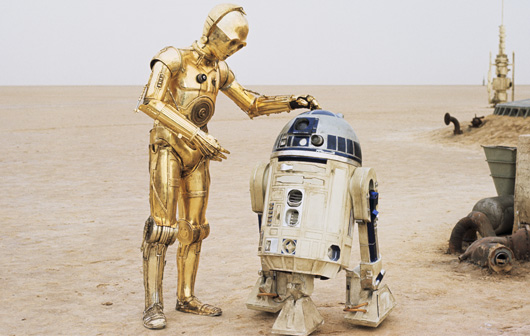
Powers places the Moisture Farm in this fourth metaterm’s position, which at first seems like an error: the Moisture Farm, with its organic shape and medievalist value system, would seem to belong to Position A. Who does belong in this position? C-3PO and R2-D2. Because they’re artifacts of the “White” world who exhibit “Brown” values. To the extent that they’re an eccentric, unpredictable, funny slapstick duo one is tempted to call them hilobrow. But this is a George Lucas movie! That doesn’t seem possible. Instead, C-3PO and R2-D2 represent a dialectical synthesis of Brown and White; they’re a symbol of hope, a sentimental promise — like Noah’s rainbow — that everything’s going to be OK. If the “White” world can turn on itself (cf. Artoo hacking into the Death Star’s systems), then the “Brown” world doesn’t have to turn against technology (cf. the Ewoks worshipping Threepio). Can’t we all just get along? Lucas asks.
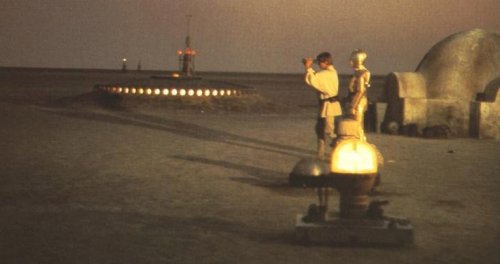
That said, perhaps the Moisture Farm, whose organic shape conceals high-tech condensers and transformers and droids, is — like Artoo and Threepio — another apt symbol of the Star Wars semiotic square’s fourth metaterm. No wonder both Brown (Luke) and White (Stormtroopers) rage against it; Luke can’t wait to leave it behind, the Stormtroopers raze it. Yet after Star Wars VI, though we’re not shown this scene, at some level we know that Luke and some ex-Stormtroopers logically ought to return to Tatooine to rebuild the Brown-White Moisture Farm. The story’s structure demands such an ending.
Considering how tentative (by his own admission: “I still cannot explain to myself in any even remotely satisfactory manner what Krauss meant by the terms neuter and complex… She explains herself in a footnote, but I am terrible at math and don’t get what she is trying to indicate”) is his grasp of the semiotic square’s logical operations, John Powers didn’t do too badly. I salute his ingenuity.
My Star Wars semiotic square is an improvement upon his, though. Someone good at drawing or photoshop should send me a diagram…
UPDATE: John Powers has responded thoughtfully to my constructive criticism, and also sent me a rendering of my Star Wars Semiotic Square:
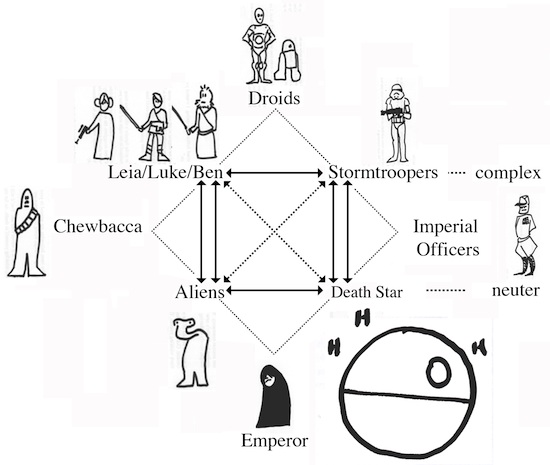
MORE FURSHLUGGINER THEORIES BY JOSH GLENN: TAKING THE MICKEY (series) | KLAATU YOU (series intro) | We Are Iron Man! | And We Lived Beneath the Waves | Is It A Chamber Pot? | I’d Like to Force the World to Sing | The Argonaut Folly | The Perfect Flâneur | The Twentieth Day of January | The Dark Side of Scrabble | The YHWH Virus | Boston (Stalker) Rock | The Sweetest Hangover | The Vibe of Dr. Strange | CONVOY YOUR ENTHUSIASM (series intro) | Tyger! Tyger! | Star Wars Semiotics | The Original Stooge | Fake Authenticity | Camp, Kitsch & Cheese | Stallone vs. Eros | The UNCLE Hypothesis | Icon Game | Meet the Semionauts | The Abductive Method | Semionauts at Work | Origin of the Pogo | The Black Iron Prison | Blue Krishma! | Big Mal Lives! | Schmoozitsu | You Down with VCP? | Calvin Peeing Meme | Daniel Clowes: Against Groovy | The Zine Revolution (series) | Best Adventure Novels (series) | Debating in a Vacuum (notes on the Kirk-Spock-McCoy triad) | Pluperfect PDA (series) | Double Exposure (series) | Fitting Shoes (series) | Cthulhuwatch (series) | Shocking Blocking (series) | Quatschwatch (series)
MORE SEMIOSIS at HILOBROW: Towards a Cultural Codex | CODE-X series | DOUBLE EXPOSURE Series | CECI EST UNE PIPE series | Star Wars Semiotics | Icon Game | Meet the Semionauts | Show Me the Molecule | Science Fantasy | Inscribed Upon the Body | The Abductive Method | Enter the Samurai | Semionauts at Work | Roland Barthes | Gilles Deleuze | Félix Guattari | Jacques Lacan | Mikhail Bakhtin | Umberto Eco
